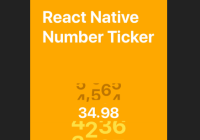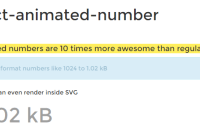Animated Timeline
Create playback based animations in React
Table of contents
Introduction
animated-timeline is an animation library (not really) for React which makes it painless to create playback based animations.
Another animation library ?
Nope! Though you can use it as a library. The main goal of this project is to provide -
-
utilities to create animation tools
-
low-level APIs to create a fitting abstraction on top of this project
-
APIs for composing animations that transition from one state to another, use loops, callbacks and timer APIs to create interactive animations
Concepts
animated-timeline works on two models, timing and animation model.
Timing model
Timing model manages the time and keeps track of current progress in a timeline.
Animation model
Animation model, on the other hand, describes how an animation could look like at any give time or it can be thought of as state of an animation at a particular point of time.
Using both the models, we can synchronize the timing and visual changes to the document.
Features
-
Controls for time-based execution of an animation
-
Create sequence based animations
-
Timing based animations
-
Change the animation position along the timeline by seeking the animation
-
Keyframes
-
Promise based APIs
-
Interactive animations based on changing inputs
-
Spring physics and bounciness
Performance
Style mutations and style reads are batched internally to speed up the performance and avoid document reflows.
Install
npm install animated-timeline or if you use yarn
yarn add animated-timeline This project also depends on react and react-dom so make sure you've them installed.
Browser support
| Chrome | Safari | IE / EDGE | Firefox | Opera |
|---|---|---|---|---|
| 24+ | 6+ | 10+ | 32+ | 15+ |
Usage
animated-timeline provides three ways to do animations:
Example usage with component API
import React from 'react' import { Animate, helpers } from 'animated-timeline' const styles = { width: '20px', height: '20px', backgroundColor: 'pink' } // Properties for timing model const timingProps = { duration: 1000 } // Properties for animation model const animationProps = { rotate: helpers.transition({ from: 360, to: 180 }) } function App() { return ( <Animate timingProps={timingProps} animationProps={animationProps}> <div style={styles} /> </Animate> ) }Read the detailed API reference for Component API
Example usage with Timeline API
import React from 'react' import { createTimeline, helpers } from 'animated-timeline' const styles = { width: '20px', height: '20px', backgroundColor: 'pink' } const t = createTimeline({ direction: 'alternate', iterations: 1 }) class App extends React.Component { componentDidMount() { t .animate({ opacity: helpers.transition({ from: 0.2, to: 0.8 }), rotate: helpers.transition({ from: 360, to: 180 }) }) .start() } render() { return <t.div style={styles} /> } }Read the detailed API reference for Timeline API
Example usage with spring physics
import React from 'react' import { Spring } from 'animated-timeline' const styles = { width: '20px', height: '20px', backgroundColor: 'pink' } const s = Spring({ friction: 4, tension: 2 }) // or // const s = Spring({ bounciness: 14, speed: 12 }) class SpringSystem extends React.Component { componentDidMount() { s.animate({ property: 'scale', map: { inputRange: [0, 1], outputRange: [1, 1.5] } }) } render() { return ( <s.div onMouseUp={() => s.setValue(0)} onMouseDown={() => s.setValue(1)} style={styles} /> ) } }Read the detailed API reference for spring physics
Animation types
Sequence based animations
Timing based animations
Staggered animation
Keyframes
Changing the animation position
You can also change the animation position along its timeline with an input value.
Spring based animations
More examples
Animation values
- For transforms
t.animate({ scale: 1, rotateX: '360deg' // with or without unit })- For css properties
t.animate({ width: '20px' })- Defining values using objects
t.animate({ rotate: { value: 360, // 360deg duration: 3000, delay: 200, direction: 'alternate' } })Check out this list to see which properties you can use when defining the animation values using objects.
from-tobased animation values
import { helpers } from 'animated-timeline' t.animate({ scale: helpers.transition({ from: 2, to: 1 }) })Read more about helpers object here.
- Timing based animation values
Use property offset to perform timing animations
import { helpers } from 'animated-timeline' t .sequence([ t.animate({ el: '.one', scale: 2 }), t.animate({ el: '.two', scale: 1, offset: helpers.startAfter(2000) }) ]) .start()You can set a value for a property with or without any unit such as px, em, rem, in, cm, mm, vw, vh, vmin, vmax, deg, rad, turn etc.
Documentation
Check out the detailed documentation for animated-timeline.
Todos
-
ReasonML port of the core engine
-
timing model based on scroll position and gestures ?
-
Synchronize engine time with speed coefficient
-
Refactor tween data structure for more flexibility
-
Use data binding










































































